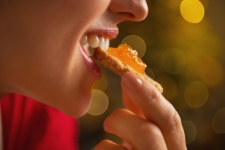Quick Tricks to Choose Healthy Snacks
Snacks get a bad rap. They’re blamed for everything from spoiling kids’ dinners to childhood obesity. Yet healthy snacks actually play a crucial role in helping kids get the nutrition they need.
Snacks between meals can give kids an energy boost -- keeping them alert and engaged in school, and providing enough fuel to be active. The Academy of Nutrition and Dietetics recommends three meals and at least two snacks each day for younger kids. Older kids should get at least one snack in addition to three meals (or two snacks, if they’re playing sports or going through a growth spurt).
Of course, you shouldn’t give your child total freedom to raid the kitchen between meals. Follow these simple guidelines so you know how to serve them well-balanced, healthy snacks:
What’s in a Healthy Snack?
Just like you put together breakfasts, lunches, and dinners that include several food groups -- carbohydrates, protein, healthy fats, fruits, and vegetables -- that nutrient balance is the goal for snacks, too. This approach can be especially helpful for picky eaters who might miss out on key nutrients at mealtimes.
well-rounded snacks to try:
- Carrot sticks (a carbohydrate and vegetable) with hummus (a protein and healthy fat)
- Banana or apple slices (carbs and fruit) with a spoonful of nut butter (protein and healthy fat)
- Whole-wheat pita (a carbohydrate) topped with tomato sauce (a veggie) and low-fat cheese (a healthy fat and protein) for a healthy take on pizza
- Greek yogurt (a carbohydrate, protein, and healthy fat) topped with fruit. (Or you can blend the two with some ice cubes to make a smoothie.)
What about cookies, chips, and other pre-packaged snacks? They may come in small containers, but they’re usually full of sugar, salt, and empty calories. They won’t fuel your kids for long.
Eyes on Portion Size
Healthy snacking isn’t just about what they’re eating, but how much of it, too. After all, snacks should tide kids over until their next meal -- not fill them up so much that they’re not hungry for that meal.
To keep snacks to a reasonable size, don’t let your kids eat directly out of the box or bag -- before they know it, they may eat the whole thing. Instead, measure out their snack into a bowl or plate.
The American Academy of Pediatrics recommends the following portion sizes for both snacks and meals:
Assess Your Symptoms
- Fruits:
- Kids ages 1 to 6: 1/4 cup cooked, frozen, or canned or 1/2 piece of fresh fruit
- Kids over 7: 1/3 cup cooked, frozen, or canned or 1 piece of fresh fruit
- Veggies:
- Kids ages 1 to 3: 1/4 cup cooked
- Kids ages 4 to 6: 1/4 cup cooked or 1/2 cup salad
- Kids over 7: 1/2 cup cooked or 1 cup salad
- Grains:
- Kids ages 1 to 3: 1/2 slice of bread, 1/4 cup cooked cereal, rice, or pasta, 1/3 cup dry cereal, or 2-3 crackers
- Kids ages 4 to 6: 1/2 slice of bread, 1/3 cup cooked cereal, rice, or pasta, 1/2 cup dry cereal, or 3-4 crackers
- Kids over 7: 1 slice of bread, 1/2 cup cooked cereal, rice, or pasta, 1 cup dry cereal, or 4-5 crackers
- Meats:
- Kids ages 1 to 3: 1 ounce of meat, fish, chicken, or tofu, 1/4 cup cooked beans, or 1/2 egg
- Kids ages 4 to 6: 1 ounce of meat, fish, chicken, or tofu, 1/3 cup cooked beans, or 1 egg
- Kids over 7: 2-3 ounces of meat, fish, chicken, or tofu, 1/2 cup cooked beans, or 1 or 2 eggs
- Dairy:
- Kids ages 1 to 3: 1/2 cup milk, 1/2 ounce cheese, or 1/3 cup yogurt
- Kids ages 4 to 6: 1/2 cup milk, 1 ounce of cheese, or 1/2 cup yogurt
- Kids over 7: 1 cup milk, 1 ounce of cheese, or 1 cup yogurt
Well-Timed Snacks
To avoid the kind of nonstop snacking that isn’t good for kids, it’s important to set snack times that make sense. Most experts agree that offering kids snacks 2 to 3 hours after one meal ends and about 1 to 2 hours before the next meal begins is ideal. If a child is allowed to have a snack right after lunch, for example, they might not be as motivated to eat the well-balanced meal on their plate. And letting them snack right before a meal means they’ll be less hungry when they sit down to eat.

